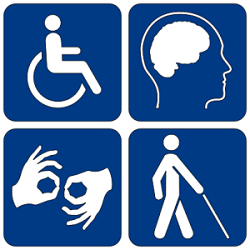ADA Accessibility —
Is Your Project or Property in Compliance? Presented by:
Richard J. Vivenzio, Director
Mona Mahal, Associate Director
Navigant Consulting, Inc. The Americans with Disabilities Act (“ADA”) was adopted by Congress in 1990. This statute is a Civil Rights law with the purpose of making certain that disabled individuals have the same rights as able-bodied individuals. The law is intended to prohibit discrimination against individuals with disabilities. Title II of the Act covers government facilities at the federal, state and local level and includes buildings, such as train stations. Title III covers all commercial facilities such as offices, retail, malls, banks and basically every other facility that is available to the public. As a result of the ADA the U.S. Department of Justice issued the Americans with Disabilities Act Accessibility Guidelines (“ADAAG”). The presenters will review the new rules such as “safe harbors,” highlight major changes, and point out potential implications for your projects. This webinar explores the scoping and technical aspects of ADAAG/ADASAD and offers guidance on how owners, contractors and operators of facilities available to the public can navigate the technical aspects of the Law and avoid claims of non-compliance. This information-packed, 90-minute recorded webinar will help you: - Learn the history of the ADA
- Understand the five sections of the law
- Become familiar with the ADAAG – the ADA Accessibility Guidelines
- Key requirements of Title II & III regulations
- Find out about ADA compliance for new building projects
- Time frames for new construction and alterations
- Discover what ADA compliance means for existing buildings
- Review ADA lawsuits to understand how ADA impacts your business
- Public accommodations
- Designer & contractor perspectives
- Learn how to comply with the Facility-related provisions
- And much, much more!
The ADA is both complicated and controversial. This webinar will provide tips on how to avoid ADA complaints and lawsuits. Order today to understand the ins and outs of the Americans with Disability Act and how it can affect you as a design professional, building owner or any type of construction manager. Who Will Benefit? This presentation is a must if you’re a building owner, contractor, subcontractor, architect, engineer or attorney. This event features key insights from our knowledgeable construction experts:  | Richard J. Vivenzio, AIA
Director, Navigant Consulting, New York Richard is an architect with more than 32 years’ experience in both design and the construction industry. He has extensive capabilities in the resolution of complex technical construction disputes involving property owners, design professionals, constructors and their insurers. Rich has served as a testifying expert in matters involving architectural standard of care, construction means and methods, water intrusion and exterior building envelope issues. He possesses a thorough working knowledge of Codes including legacy codes such as BOCA and has been deemed an expert in matters involving the ADA and has assisted building owners in the resolution of ADA disputes and performed advisory services to owners who proactively choose to provide ADA upgrades. Click here for a complete bio. |  | Mona Mahal
Associate Director, Navigant Consulting, New York Ms. Mahal has more than 15 years of experience in both design and construction. She has extensive experience in capital project management from planning through construction including architectural design and dispute resolution involving residential, commercial, educational and institutional projects. This experience includes leading pre-construction, construction and operations meetings with all parties, establishing lines of communication between the Owner and its stakeholders, Contractors and the Design team, overseeing construction activities, logistics planning, budget tracking and coordinating project closeout. Mona has provided advisory third party constructability review of construction documents on healthcare and high rise residential projects. |
|



